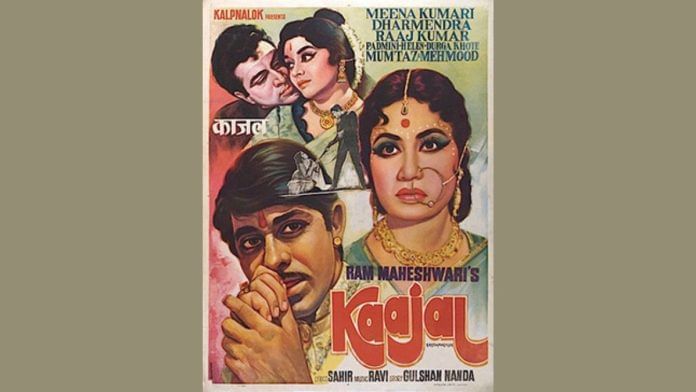The year was 1965. Actor Raaj Kumar had just starred in Yash Chopra’s family ensemble Waqt and Ram Maheshwari’s romantic drama Kaajal. Both went on to become that year’s biggest blockbusters. For his turn as Moti in Kaajal, Kumar earned his career’s only Filmfare nomination for Best Actor.
The nearly three-hour-long film is a twist-heavy melodrama—almost like an Ekta Kapoor daily soap from the 2000s. The film is based on a story by Gulshan Nanda–Bollywood’s go-to person for tearjerkers in the 1960s and 1970s. Nanda’s stories became iconic films like Khilona (1970), Kati Patang (1971), Sharmeelee (1971) and Daag (1973). Kaajal however was the first big success, and it followed the trope familiar in Nanda’s stories—the stereotypical ‘good’ and wronged woman and the tortured male hero, who is good at heart but takes time to appreciate the woman in his life.
Kaajal follows the young orphan Madhavi (Meena Kumari) who lives in her father’s employer’s haveli. She is doted on by the woman of the house, Rani maa (Durga Khote). She has grown up with Rani maa’s son Rajesh (Dharmendra) and her brother Kaushal (Sailesh Kumar).
Rajesh marries Bhanu (Padmini), while Kaushal dies in an accident. Bhanu is jealous of Madhavi’s presence. Tired of her accusations, Madhavi runs away, ready to die, only to be rescued by her knight in shining armour, Moti (Raaj Kumar). However, he is not who or what he initially appears, and Madhavi’s life takes a new, stormy course.
Maheshwari deftly uses every possible plot device to steer the story forward, all of which appear too convoluted for its own good. The only thing that holds the film together are the performances of its cast.
Also read: A ghost, war veteran & a lost nation—Hrishikesh Mukherjee’s Naukri was ahead of its time
Balancing the script’s melodrama
After Kumar’s hit pairing with Meena Kumari in Dil Apna Aur Preet Parai (1961), the duo once again show that their on-screen chemistry is electric. While in Dil Apna Aur Preet Parai, the two play star-crossed lovers, exchanging sighs and glances in the corridors of a hospital, the situation in Kaajal is quite different.
As the scheming, bitter Moti, Kumar gets a chance to show his versatility as an actor. He matches Kumari’s performance of being the misunderstood woman with complete ease. From losing her brother in a freak accident to being accused of being the ‘other woman’, and finally hitched to a man who has an ulterior motive, Kumari portrays Madhavi’s helplessness and pain with elan.
Kumar’s performance too is restrained, even though he could easily have slipped into showing his character’s upbringing, and eventual descent into debauchery in an exaggerated manner. Known for his unique dialogue delivery and often stylish avatars, Kumar opts for subtlety in Kaajal. His eyes alternate with ease between anger and pain, as he tries to reclaim what he believes is rightfully his.
In the song Chhoo Lene Do, the two are at their best. Moti urges Madhavi to drink, and she, horrified by the suggestion, quietly sheds tears. But Moti keeps singing, courting her. It is a twisted moment of male desire oblivious to the pain of his wife, who is trying to maintain the relationship. It also shows how Moti, for all his debauchery and bitterness, does not really despise her.
Dharmendra, who shares the screen with Kumari in the initial bits of the film, has a smaller role. But he still elevates the film with his performance as the man torn between his wife and his childhood companion. But it is ultimately a Raja Kumar-Meena Kumari show through and through.
Real life tussle
Kaajal features 12 songs, which were divided among Mohammad Rafi, Mahendra Kapoor and Asha Bhonsle. With Sahir Ludhianvi writing magic in the lyrics, and Ravi getting together the three singers, the film’s album is exceptional. While Chhoo Lene Do stands out for Rafi’s rendition, so does the bhajan Tora Man Darpan, by Rafi and Bhonsle, which appears right in the beginning of the film.
Chham Chham Ghungroo by Asha Bhonsle is a face-off of sorts, where Madhavi plays on the sitar, and Bhanu dances. Rajesh and Moti, dressed in dapper black suits, look on from the sidelines.
The film ends with an altercation between Moti and Rajesh, which was an eerie mirroring of what transpired on the film’s sets. In the film, Moti taunts Rajesh for his poverty, and during the shoot, Kumar had mocked Dharmendra’s muscular build.
Kumar asked director Maheshwari whether he required an actor or a wrestler for the part. Though initially silent, Dharmendra lost his cool when Kumar called him a monkey.
Dharmendra had reportedly grabbed Raaj Kumar by the collar before the crew intervened to de-escalate. The shoot was halted for a few days before the two eventually reconciled and filming resumed. The film’s success provided a boost to the careers of all the actors.
(Edited by Theres Sudeep)






